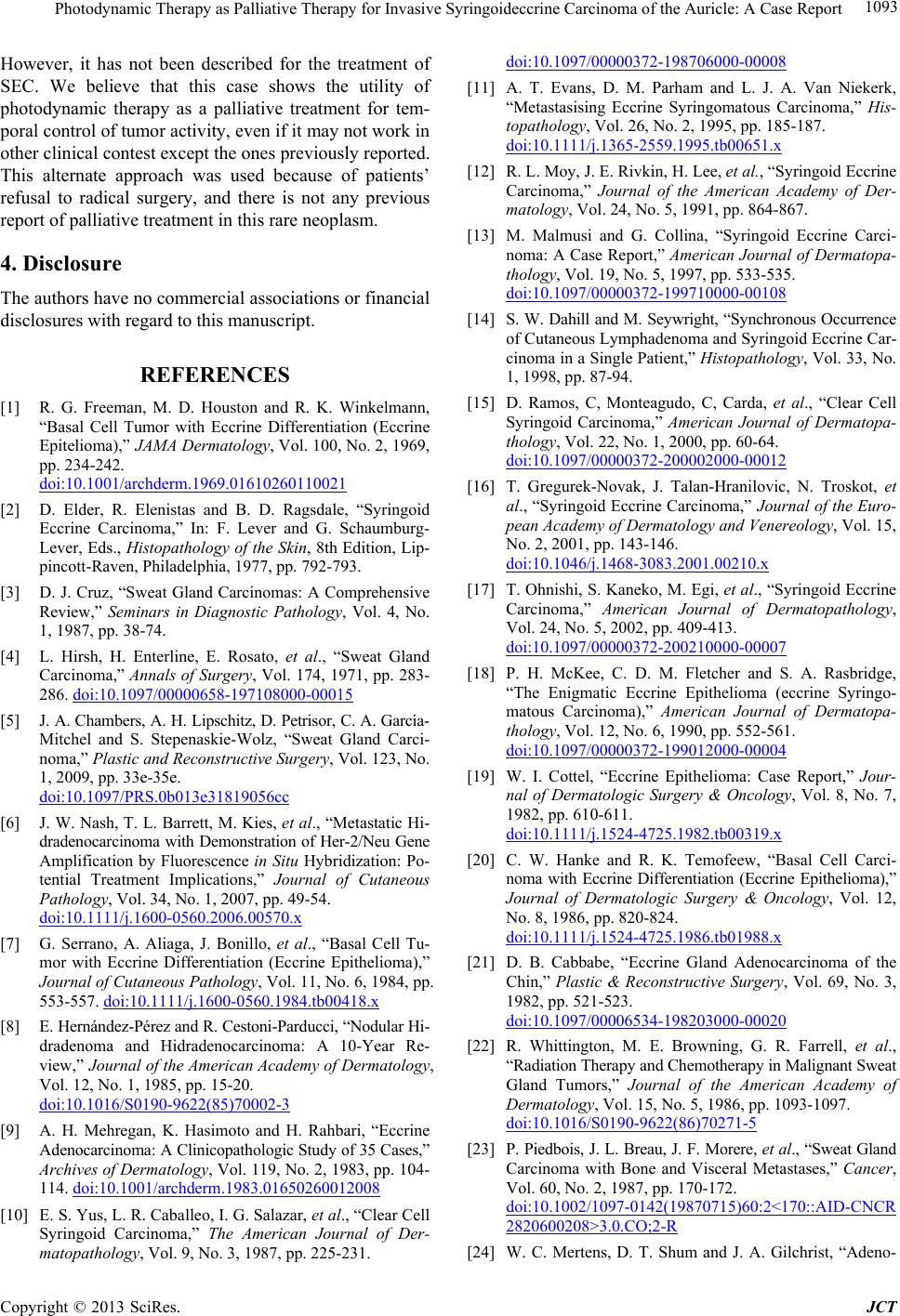
Photodynamic Therapy as Palliative Therapy for Invasive Syringoideccrine Carcinoma of the Auricle: A Case Report 1093
However, it has not been described for the treatment of
SEC. We believe that this case shows the utility of
photodynamic therapy as a palliative treatment for tem-
poral control of tumor activity, even if it may not work in
other clinical contest except the ones previously reported.
This alternate approach was used because of patients’
refusal to radical surgery, and there is not any previous
report of palliative treatment in this rare neoplasm.
4. Disclosure
The authors have no commercial associations or financial
disclosures with regard to this manuscript.
REFERENCES
[1] R. G. Freeman, M. D. Houston and R. K. Winkelmann,
“Basal Cell Tumor with Eccrine Differentiation (Eccrine
Epitelioma),” JAMA Dermatology, Vol. 100, No. 2, 1969,
pp. 234-242.
doi:10.1001/archderm.1969.01610260110021
[2] D. Elder, R. Elenistas and B. D. Ragsdale, “Syringoid
Eccrine Carcinoma,” In: F. Lever and G. Schaumburg-
Lever, Eds., Histopathology of the Skin, 8th Edition, Lip-
pincott-Raven, Philadelphia, 1977, pp. 792-793.
[3] D. J. Cruz, “Sweat Gland Carcinomas: A Comprehensive
Review,” Seminars in Diagnostic Pathology, Vol. 4, No.
1, 1987, pp. 38-74.
[4] L. Hirsh, H. Enterline, E. Rosato, et al., “Sweat Gland
Carcinoma,” Annals of Surgery, Vol. 174, 1971, pp. 283-
286. doi:10.1097/00000658-197108000-00015
[5] J. A. Chambers, A. H. Lipschitz, D. Petrisor, C. A. García-
Mitchel and S. Stepenaskie-Wolz, “Sweat Gland Carci-
noma,” Plastic and Reconstructive Surgery, Vol. 123, No.
1, 2009, pp. 33e-35e.
doi:10.1097/PRS.0b013e31819056cc
[6] J. W. Nash, T. L. Barret t, M. Kies, et al., “Metastatic Hi-
dradenocarcinoma with De monstration of Her-2/Neu Gene
Amplification by Fluorescence in Situ Hybridization: Po-
tential Treatment Implications,” Journal of Cutaneous
Pathology, Vol. 34, No. 1, 2007, pp. 49-54.
doi:10.1111/j.1600-0560.2006.00570.x
[7] G. Serrano, A. Aliaga, J. Bonillo, et al., “Basal Cell Tu-
mor with Eccrine Differentiation (Eccrine Epithelioma),”
Journal of Cutaneous Pathology, Vol. 11, No. 6, 1984, pp.
553-557. doi:10.1111/j.1600-0560.1984.tb00418.x
[8] E. Hernández-Pérez and R. Cestoni-Parducci, “Nodular Hi-
dradenoma and Hidradenocarcinoma: A 10-Year Re-
view,” Journal of the American Academy of Dermatology,
Vol. 12, No. 1, 1985, pp. 15-20.
doi:10.1016/S0190-9622(85)70002-3
[9] A. H. Mehregan, K. Hasimoto and H. Rahbari, “Eccrine
Adenocarcin oma: A Clinicopathologic Study of 35 Cases,”
Archives of Dermatology, Vol. 119, No. 2, 1983, pp. 104-
114. doi:10.1001/archderm.1983.01650260012008
[10] E. S. Yus, L. R. Caballeo, I. G. Salazar, et al., “Clear Cell
Syringoid Carcinoma,” The American Journal of Der-
matopathology, Vol. 9, No. 3, 1987, pp. 225-231.
doi:10.1097/00000372-198706000-00008
[11] A. T. Evans, D. M. Parham and L. J. A. Van Niekerk,
“Metastasising Eccrine Syringomatous Carcinoma,” His-
topathology, Vol. 26, No. 2, 1995, pp. 185-187.
doi:10.1111/j.1365-2559.1995.tb00651.x
[12] R. L. Moy, J. E. Rivkin, H. Lee, et al., “Syringoid Eccrine
Carcinoma,” Journal of the American Academy of Der-
matology, Vol. 24, No. 5, 1991, pp. 864-867.
[13] M. Malmusi and G. Collina, “Syringoid Eccrine Carci-
noma: A Case Report,” American Journal of Dermatopa-
thology, Vol. 19, No. 5, 1997, pp. 533-535.
doi:10.1097/00000372-199710000-00108
[14] S. W. Dahill and M. Seywright, “Synchronous Occurrence
of Cutaneous Lymphadenoma and Syringoid Eccrine Car-
cinoma in a Single Patient,” Histopathology, Vol. 33, No.
1, 1998, pp. 87-94.
[15] D. Ramos, C, Monteagudo, C, Carda, et al., “Clear Cell
Syringoid Carcinoma,” American Journal of Dermatopa-
thology, Vol. 22, No. 1, 2000, pp. 60-64.
doi:10.1097/00000372-200002000-00012
[16] T. Gregurek-Novak, J. Talan-Hranilovic, N. Troskot, et
al., “Syringoid Eccrine Carcinoma,” Journal of the Euro-
pean Academy of Dermatology and Venereology, Vol. 15,
No. 2, 2001, pp. 143-146.
doi:10.1046/j.1468-3083.2001.00210.x
[17] T. Ohnishi, S. Kaneko, M. Egi, et al., “Syringoid Eccrine
Carcinoma,” American Journal of Dermatopathology,
Vol. 24, No. 5, 2002, pp. 409-413.
doi:10.1097/00000372-200210000-00007
[18] P. H. McKee, C. D. M. Fletcher and S. A. Rasbridge,
“The Enigmatic Eccrine Epithelioma (eccrine Syringo-
matous Carcinoma),” American Journal of Dermatopa-
thology, Vol. 12, No. 6, 1990, pp. 552-561.
doi:10.1097/00000372-199012000-00004
[19] W. I. Cottel, “Eccrine Epithelioma: Case Report,” Jour-
nal of Dermatologic Surgery & Oncology, Vol. 8, No. 7,
1982, pp. 610-611.
doi:10.1111/j.1524-4725.1982.tb00319.x
[20] C. W. Hanke and R. K. Temofeew, “Basal Cell Carci-
noma with Eccrine Differentiation (Eccrine Epithelioma),”
Journal of Dermatologic Surgery & Oncology, Vol. 12,
No. 8, 1986, pp. 820-824.
doi:10.1111/j.1524-4725.1986.tb01988.x
[21] D. B. Cabbabe, “Eccrine Gland Adenocarcinoma of the
Chin,” Plastic & Reconstructive Surgery, Vol. 69, No. 3,
1982, pp. 521-523.
doi:10.1097/00006534-198203000-00020
[22] R. Whittington, M. E. Browning, G. R. Farrell, et al.,
“Radiation Therapy and Chemoth erapy in Malignant Sweat
Gland Tumors,” Journal of the American Academy of
Dermatology, Vol. 15, No. 5, 1986, pp. 1093-1097.
doi:10.1016/S0190-9622(86)70271-5
[23] P. Piedbois, J. L. Breau, J. F. More re, et al., “Sweat Gland
Carcinoma with Bone and Visceral Metastases,” Cancer,
Vol. 60, No. 2, 1987, pp. 170-172.
doi:10.1002/1097-0142(19870715)60:2<170::AID-CNCR
2820600208>3.0.CO;2-R
[24] W. C. Mertens, D. T. Shum and J. A. Gilchrist, “Adeno-
Copyright © 2013 SciRes. JCT